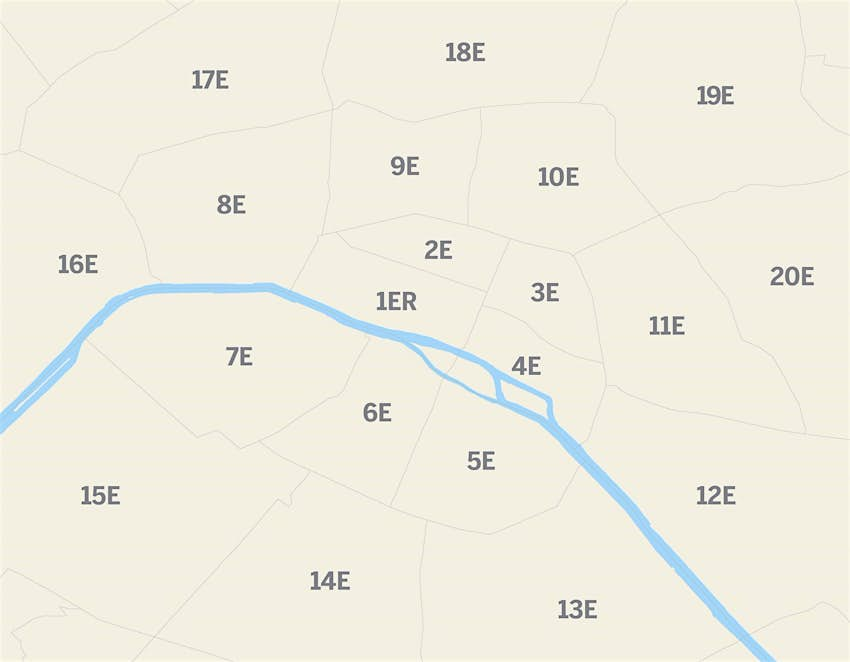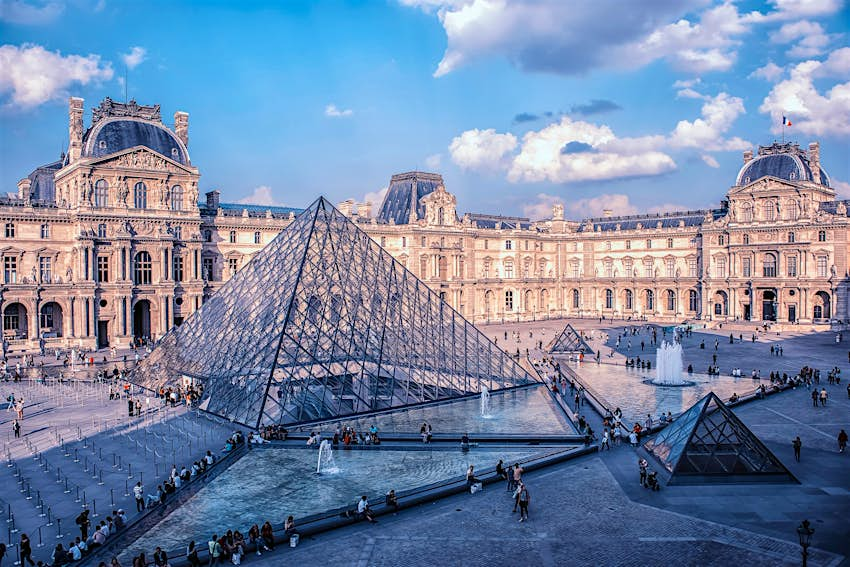Best Arrondissement to Stay in Paris for Families

Paris is a mosaic of densely populated neighborhoods, known equally arrondissements, which screw clockwise like a snail trounce from the Left Depository financial institution (due south) and Right Bank (north) of the Seine River right upwards to the périphérique (ring road) that encircles the city.
Each arrondissement has its own distinctive personality and draws for visitors, from the raucous jazz bars of the Latin Quarter (5th Arrondissement) to the leafy parks of the far-flung 19th Arrondissement. Hither we provide a cursory overview of all 20 Paris arrondissements, with details of the elevation attractions for travelers in each.

A handy tip: The last 2 numbers of whatsoever Paris postcode (which offset with the city's département number, 75) indicate which arrondissement that location is in. For instance, 75001 means the 1st Arrondissement, and 75002 is in the 2nd Arrondissement. These numbers make it easy to quickly check the location of hotels and rental apartments in the metropolis (postcodes that don't start with 75 fall outside the périphérique).

1st Arrondissement
Best neighborhood for sightseeing
Primarily assail the Correct Depository financial institution, Paris' elegant 1st Arrondissement (premier)has the fewest residents but a huge number of sights, including the Musée du Louvre, stately gardens Jardin des Tuileries and Jardin du Palais Royal, contemporary art museum Collection Pinault – Paris, and awning-topped shopping mall and transport hub Forum des Halles on the site of the city's former wholesale markets. The 1st Arrondissement also takes in the western wedge of the Île de la Cité (the larger of fundamental Paris' two inhabited islands), which hides the ethereal stained-glass chapel Sainte-Chapelle.

2nd Arrondissement
Best neighborhood for celebrated passageways and pretty streets
Paris' smallest district, the 2d Arrondissement (deuxième) contains many of the city'south 19th-century drinking glass-roofed covered passages, including the oldest, Passage des Panoramas. Street stalls and nutrient shops such as Stohrer, a bakery opened in 1730, line pedestrianized Rue Montorgueil, whose northern extension, Rue des Petits Carreaux, heads into the vestiges of Paris' garment-making district, Sentier, hopping with bistros and bars.

3rd Arrondissement
Best neighborhood for cafes and museums
Known every bit the Haut Marais (Upper Marais), the 3rd Arrondissement (troisième) underwent a mid-2000s metamorphosis and today bursts with design ateliers and stylish cafes. Unmissable sights include the Musée National Picasso, in a mid-17th-century private mansion, and the Musée Carnavalet, retelling the history of the French capital.

4th Arrondissement
Best neighborhood for hip Paris and world famous heritage sites
Office of the quaternary Arrondissement (quatrième), the Le Marais district received a facelift of its own in the 1960s and '70s and remains ane of Paris' about fashionable addresses. The multifaceted quaternary Arrondissement is also home to thriving Jewish and LGBTQI+ communities, and the iconic Centre Pompidou cultural center, displaying modern and contemporary art. Also within this area is the eastern finish of the Île de la Cité island, dominated by Notre Dame. The smaller island to its east, boutique-lined Île St-Louis, is the dwelling of Berthillon ice cream.

fifth Arrondissement
Best neighborhood for nightlife
Fanning out around La Sorbonne's prestigious university campus on the Left Bank, the student-filled 5th Arrondissement (cinquième), also known every bit the Latin Quarter, abounds with secondhand bookstores and record shops, inexpensive restaurants, fine art-deco cinemas, jazz clubs and late-night bars. The Musée National du Moyen Âge incorporates both medieval and Roman-era compages, while natural history museums are located in the botanic gardens of Jardin des Plantes. French luminaries are laid to balance in the domed Panthéon mausoleum.

sixth Arrondissement
Best neighborhood for quintessential Paris
Famed for fabulous literary cafes like Les Deux Magots, which sits reverse the city's oldest church, 11th-century Église St-Germain des Prés, the quintessentially Parisian 6th Arrondissement (sixième) is a jewel-box of exquisite boutiques, restaurants and hotels. In the arrondissement's southeast is the chestnut-shaded park Jardin du Grand duchy of luxembourg, where children prod 1920s wooden toy sailboats on its octagonal pond.

7th Arrondissement
All-time neighborhood for iconic Paris landmarks
W along the Left Bank is the wealthy 7th Arrondissement (septième). Shaped like a fan, its attractions span the impressionist art showcase Musée d'Orsay, the Musée Rodin'due south sculpture-filled mansion and rose garden, and the indigenous and folk-fine art museum, Musée du Quai Branly – Jacques Chirac. Manicured lawns front the fundamental Hôtel des Invalides military complex containing Napoléon's tomb. To the west is Paris' emblematic Eiffel Tower.

8th Arrondissement
Best neighborhood for luxury shopping
Back on the Right Bank, the grand 8th Arrondissement (huitième) is bisected by broad avenues including the Champs-Élysées, bookended past the mighty Arc de Triomphe and the vast Identify de la Concorde, where Louis Xvi was guillotined. Avenues Champs-Élysées, George V and Montaigne form the Triangle d'Or (Aureate Triangle), dwelling to flagship fashion houses like Chanel and Dior. Gourmet emporiums surround Place de la Madeleine's Grecian temple-style church Église de la Madeleine.

ninth Arrondissement
Best neighborhood for section stores and markets
Eastwards, the 9th Arrondissement (neuvième) is the home of Paris' original and well-nigh famous opera business firm, Palais Garnier, thanks to a starring function in Gaston Leroux's 1910 novel The Phantom of the Opera. It's also where you lot'll discover art-nouveau department stores Galeries Lafayette and Le Printemps. Foodie street Rue des Martyrs, with fromageries (cheese stores), boulangeries (bakeries) and more, extends uphill from here, while glamorous cocktail bars such as Lule White cluster in the north.

10th Arrondissement
All-time neighborhood for transport links and canal-side dining
Grittier than the arrondissements that precede it, the 10th Arrondissement (dixième) is many visitors' introduction to Paris: railroad train stations Gare du Nord and Gare de 50'Est are both here. Atomic number 26 footbridge-spanned Canal St-Martin'south revival continues speedily cheers to indie-run bars, restaurants, shops and cultural centers such every bit Betoken Éphémère.

11th Arrondissement
All-time neighborhood for creatives
Domicile to traditional furniture makers and a new moving ridge of graphic designers and multimedia artists, Paris' most densely populated arrondissement, the 11th (onzième), is a hotbed of inventiveness, with a foundry-housed digital museum, L'Atelier des Lumières, craft breweries, collaborative coffee roasteries and sizzling new restaurant openings. Rue Oberkampf, with live-music and DJ venues, is the area's nightlife spine.

twelfth Arrondissement
Best neighborhood for local flair

13th Arrondissement
Best neighborhood for unique flavors
Across on the Left Bank, the 13th Arrondissement (treizième) is home to Paris' largest Chinatown, where Asian bakeries and Buddhist temples are surrounded by a wood of skyscrapers, many used as behemothic street-fine art canvases. Elsewhere, innovations like the book-shaped national library Bibliothèque Nationale de France and repurposed industrial sites – such as the former railway depot now housing startup campus Station F – make the regenerating 13th Arrondissement unlike anywhere else in Paris.

14th Arrondissement
Best neighborhood for catacombs and crêperies
The northern part of the 14th Arrondissement (quatorzième) is the entry point for skull-and-bone-lined subterranean tunnels Les Catacombes, long-standing Montparnasse brasseries such as Le Select and stacks of Breton crêperies. By and large residential, the south part of the district shelters leafy Parc Montsouris.

15th Arrondissement
Best neighborhood for humming streets
Farthest west on the Left Bank, the sweeping 15th Arrondissement (quinzième) is Paris' well-nigh populous, with a mix of 19th-century and modern apartment blocks. Sights are few, but parks here include Parc André Citroën, home to the helium-filled Ballon de Paris providing aerial views, and artificial island Île aux Cygnes.

16th Arrondissement
Best neighborhood for woodland walks
Incorporating the large Bois de Boulogne woodland expanse, the swanky Right Bank 16th Arrondissement (seizième) is Paris' largest geographically. Pinnacle draws include the Palais de Chaillot's trio of museums overlooking the terraced Jardins du Trocadéro, while the hunting social club-housed Musée Marmottan Monet is among its lesser-known gems.

17th Arrondissement
All-time neighborhood for off-the-beaten-rails Paris
Outside of Paris visitors' usual itineraries, the 17th Arrondissement (dix-septième) is a mashup of classical Parisian residences, rejuvenated post-industrial areas and Clichy-Batignolles, a sustainable new "eco quarter."

18th Arrondissement
All-time neighborhood for city views
The 18th Arrondissement (dix-huitième) is synonymous with Montmartre'south steep, ivy-clad streets crowned past hilltop Sacré-Cœur basilica. Portrait artists on touristy Place du Tertre call back the days when Picasso, Braque and Modigliani lived and worked here, though the throngs of tourists tin detract from the romance of the expanse. To Montmartre's due south is the (tame) red-lite district Pigalle, home to the Moulin Rouge cabaret, while to its eastward, Château Rouge and La Goutte d'Or make up Paris' "Little Africa" neighborhood, with aromatic street markets, colorful fabric shops and a vibrant music scene.

19th Arrondissement
All-time neighborhood for green spaces
Few tourists venture out to the far-flung 19th Arrondissement (dix-neuvième), but despite some rough edges, highlights include the futuristic Parc de la Villette with museums and wide-ranging music venues including the Philharmonie de Paris concert hall, and the idyllic Parc des Buttes Chaumont with grottoes, waterfalls and a lake.

20th Arrondissement
Best neighborhood for paying respect to famous names
Paris' 20th Arrondissement (vingtième) is dwelling to Cimetière du Père Lachaise, burial identify of famous names including Jim Morrison, Oscar Wilde, Édith Piaf and countless other celebrities. Otherwise under-the-radar, information technology takes in the gentrifying neighborhoods of Ménilmontant and Belleville (which technically straddles four arrondissements), with creative person studios and wonderfully former-school hangouts such every bit Le Vieux Belleville, hosting piano accordion-accompanied chansons.
This article was originally published in June 2019.
See our full range of France travel books

Make the most of your time in France with Lonely Planet's range of travel guides and phrasebooks. Be the architect of your own trip as you discover the best things to do in France through insider tips, suggested itineraries, and handy maps.
Source: https://www.lonelyplanet.com/articles/guide-paris-arrondissements
0 Response to "Best Arrondissement to Stay in Paris for Families"
Post a Comment